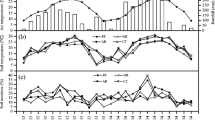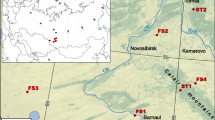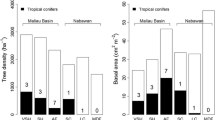Abstract
Aims
We analysed current carbon (C) stocks in fine root and aboveground biomass of riparian forests and influential environmental parameters on either side of a dike in the Donau-Auen National Park, Austria.
Methods
On both sides of the dike, carbon (C) stock of fine roots (CFR) under four dominant tree species and of aboveground biomass (CAB) were assessed by topsoil cores (0–30 cm) and angle count sampling method respectively (n = 48). C stocks were modeled, performing boosted regression trees (BRT).
Results
Overall CFR was 2.8 t ha−1, with significantly higher C stocks in diked (DRF) compared to flooded riparian forests (FRF). In contrast to CFR, mean CAB was 123 t ha−1 and lower in DRF compared to FRF. However, dike construction was consistently ruled out as a predictor variable in BRT. CFR was influenced by the distance to the Danube River and the dominant tree species. CAB was mainly influenced by the magnitude of fluctuations in the groundwater table and the distances to the river and the low groundwater table.
Conclusions
Despite pronounced differences in FRF and DRF, we conclude that there is only weak support that dikes directly influence C allocation in floodplain forests within the time scale considered (110 years).





Similar content being viewed by others
Abbreviations
- BRT:
-
Boosted regression trees
- C:
-
Carbon
- CFR:
-
C stock of fine root biomass
- CAB:
-
C stock of aboveground biomass
- DBH:
-
Diameter at breast height
- DRF:
-
Diked riparian forest
- FRF:
-
Flooded riparian forest
- NPP:
-
Net primary production
- SE:
-
Standard error
- TRF:
-
Total riparian forest
References
Baird KJ, Stromberg JC, Maddock T (2005) Linking riparian dynamics and groundwater: an ecohydrologic approach to modeling groundwater and riparian vegetation. Environ Manag 36:551–564
Baker TT, Conner WH, Lockaby GB, Stanturf JA, Burke MK (2001) Fine root productivity and dynamics on a forested floodplain in South Carolina. Soil Sci Soc Am J 65:545–556
Bendix J, Hupp CR (2000) Hydrological and geomorphological impacts on riparian plant communities. Hydrol Process 14:2977–2990
BMU (2003) Hydrologischer Atlas von Deutschland (HAD). Bundesministerium für Umwelt, Naturschutz und Reaktorsicherheit (ed), Bonn/Berlin
BMU (2009) Auenzustandsbericht. Flussauen in Deutschland. Bundesministerium für Umwelt, Naturschutz und Reaktorsicherheit (ed), Berlin
Bonn S, Roloff A (2002) Konkurrenzdynamik und Ökophysiologie der wichtigsten Baumarten in Hartholzauenwäldern an der mittleren Elbe. Roloff A, Bonn S (eds) Ergebnisse ökologischer Forschung zur nachhaltigen Bewirtschaftung von Auenwäldern an der Mittleren Elbe. Forstwiss Beitr Tharandt/Contrib For Sci 17:7–59
Brinson MM, Lugo AE, Brown S (1981) Primary productivity, decomposition and consumer activity in freshwater wetlands. Annu Rev Ecol Syst 12:123–161
Burke MK, Chambers JL (2003) Root dynamics in bottomland hardwood forests of the Southeastern United States Coastal Plain. Plant Soil 250:141–153
Burke MK, Raynal DJ (1994) Fine root growth phenology, production, and turnover in a northern hardwood forest ecosystem. Plant Soil 162:135–146
Cabezas A, Comín FA (2010) Carbon and nitrogen accretion in the topsoil of the Middle Ebro River floodplains (NE Spain): implications for their ecological restoration. Ecol Eng 36:640–652
Cavalcanti GG, Lockaby BG (2005) Effects of sediment deposition on fine root dynamics in riparian forests. Soil Sci Soc Am J 69:729–737
Chave J, Muller-Landau HC, Baker TR, Easdale TA, ter Steege H, Webb CO (2006) Regional and phylogenetic variation of wood density across 2456 neotropical tree species. Ecol Appl 16:2356–2367
Cierjacks A, Kleinschmit B, Babinsky M, Kleinschroth F, Markert A, Menzel M et al (2010) Carbon stocks of soil and vegetation on Danubian floodplains. J Plant Nutr Soil Sci 173:644–653
Cierjacks A, Kleinschmit B, Kowarik I, Graf M, Lang F (2011) Organic matter distribution in floodplains can be predicted using spatial and vegetation structure data. River Res Appl 27:1048–1057
Conner WH, Gosselink JG, Parrondo RT (1981) Comparison of the vegetation of three Louisiana swamp sites with different flooding regimes. Am J Bot 68:320–331
Day FP, Megonigal JP (1993) The relationship between variable hydroperiod, production allocation, and belowground organic turnover in forested wetlands. Wetlands 13:115–121
Day FP, West SK, Tupacz EG (1988) The influence of ground-water dynamics in a periodically flooded ecosystem, the Great Dismal Swamp. Wetlands 8:1–13
Day FP, Weber EP, Hinkle CR, Drake BG (1996) Effects of elevated atmospheric CO2 on fine root length and distribution in an oak-palmetto scrub ecosystem in Central Florida. Glob Chang Biol 2:143–148
De’ath G, Fabricius KE (2000) Classification and regression trees: a powerful yet simple technique for ecological data analysis. Ecology 81:3178–3192
Elderd BD (2003) The impact of changing flow regimes on riparian vegetation and the riparian species Mimulus guttatus. Ecol Appl 13:1610–1625
Elith J, Leathwick JR, Hastie T (2008) A working guide to boosted regression trees. J Anim Ecol 77:802–813
Erwin KL (2009) Wetlands and global climate change: the role of wetland restoration in a changing world. Wetl Ecol Manag 17:71–84
Fierke MK, Kauffman JB (2005) Structural dynamics of riparian forests along a black cottonwood successional gradient. For Ecol Manag 215:149–162
Fox J (2008) Applied regression analysis and generalized linear models. Sage Publications, Los Angeles
Friedman JM, Osterkamp WR, Lewis WM (1996) The role of vegetation and bed-level fluctuations in the process of channel narrowing. Geomorphology 14:341–351
Giese LA, Aust WM, Trettin CC, Kolka RK (2000) Spatial and temporal patterns of carbon storage and species richness in three South Carolina coastal plain riparian forests. Ecol Eng 15:S157–S170
Giese LAB, Aust WM, Kolka RK, Trettin CC (2003) Biomass and carbon pools of disturbed riparian forests. For Ecol Manag 180:493–508
Grier CC, Vogt KA, Keyes MR, Edmonds RL (1981) Biomass distribution and above- and belowground production in young and mature Abies amabilis zone ecosystems of the Washington Cascades. Can J For Res 11:155–167
Haubenberger G, Weidinger H (1990) Gedämmte Au - Geflutete Au. Vergleichende Grundlagenforschung zur forstökologischen Beurteilung abgedämmter und gefluteter Auwaldstandorte östlich von Wien. Magistratsabteilung 49, Forstamt und Landwirtschaftsbetrieb der Stadt Wien (ed), Vienna, Austria
Hazlett PW, Gordon AM, Sibley PK, Buttle JM (2005) Stand carbon stocks and soil carbon and nitrogen storage for riparian and upland forests of boreal lakes in Northeastern Ontario. For Ecol Manag 219:56–68
Hohensinner S, Jungwirth M, Muhar S, Schmutz S (2011) Spatio-temporal habitat dynamics in a changing Danube River landscape 1812–2006. River Res Appl 27:939–955
Horton JL, Kolb TE, Hart SC (2001a) Physiological response to groundwater depth varies among species and with river flow regulation. Ecol Appl 11:1046–1059
Horton JL, Kolb TE, Hart SC (2001b) Responses of riparian trees to interannual variation in ground water depth in a semi-arid river basin. Plant Cell Environ 24:293–304
IPCC JJ (2001) Climate change 2001. Impacts, adaptation and vulnerability; contribution of Working Group II to the third assessment report of the Intergovernmental Panel on Climate Change. Cambridge Univ Press, Cambridge
Jackson MB, Attwood PA (1996) Roots of willow (Salix viminalis L.) show marked tolerance to oxygen shortage in flooded soils and in solution culture. Plant Soil 187:37–45
Jackson RB, Mooney HA, Schulze ED (1997) A global budget for fine root biomass, surface area, and nutrient contents. Proc Natl Acad Sci USA 94:7362–7366
Jacobson RB, O’Connor JE, Oguchi T (2003) Surficial geologic tools in fluvial geomorphology. In: Kondolf GM, Piégay H (eds) Tools in fluvial geomorphology. Wiley, Chichester, pp 25–57
Kiley DK, Schneider RL (2005) Riparian roots through time, space and disturbance. Plant Soil 269:259–272
Koop H (1987) Vegetative reproduction of trees in some European natural forests. Vegetatio 72:103–110
Kramer H, Akça A (2002) Leitfaden zur Waldmeßlehre, 4. Aufl. Sauerländer's Verlag, Frankfurt am Main
Lehtonen A, Mäkipää R, Heikkinen J, Sievänen R, Liski J (2004) Biomass expansion factors (BEFs) for scots pine, norway spruce and birch according to stand age for boreal forests. For Ecol Manag 188:211–224
McClaugherty CA, Aber JD, Melillo JM (1982) The role of fine roots in the organic matter and nitrogen budgets of two forested ecosystems. Ecology 63:1481–1490
McTammany ME, Webster JR, Benfield EF, Neatrour MA (2003) Longitudinal patterns of metabolism in a southern Appalachian River. J N Am Benthol Soc 22:359–370
Megonigal JP, Day FP (1992) Effects of flooding on root and shoot production of bald cypress in large experimental enclosures. Ecology 73:1182–1193
Meinen C, Hertel D, Leuschner C (2009) Biomass and morphology of fine roots in temperate borad-leaved forests differing in tree species diversity: is there evidence of below-ground overyielding? Oecologia 161:99–111
Merritt DM, Cooper DJ (2000) Riparian vegetation and channel change in response to river regulation: a comparative study of regulated and unregulated streams in the Green River Basin, USA. Regul Rivers Res Manag 16:543–564
Mitsch WJ, Ewel KC (1979) Comparative biomass and growth of cypress in Florida wetlands. Am Midl Nat 101:417–426
Nadelhoffer KJ, Raich JW (1992) Fine root production estimates and belowground carbon allocation in forest ecosystems. Ecology 73:1139–1147
Naiman RJ, Décamps H (1997) The ecology of interfaces: riparian zones. Annu Rev Ecol Syst 28:621–658
Persson H (1980a) Death and replacement of fine roots in a mature scots pine stand. Ecol Bull (Stockholm) 32:251–260
Persson H (1980b) Spatial distribution of fine-root growth, mortality and decomposition in a young scots pine stand in Central Sweden. Oikos 34:77–87
Piégay H, Schumm SA (2009) System approaches in fluvial geomorphology. In: Kondolf GM, Piégay H (eds) Tools in fluvial geomorphology. Wiley, Chichester, pp 105–134
Pregitzer KS, Friend AL (1996) The structure and function of Populus root systems. In: Stettler RF, Bradshaw HD Jr, Heilman PE, Hinckley TM (eds) Biology of Populus and its implications for management and conservation. NRC Res Press, Ottawa, pp 331–354
R Development Core Team (2012) R: A language and environment for statistical computing. R foundation for statistical computing, Vienna, Austria. ISBN 3-900051-07-0, URL http://www.R-project.org, Accessed 09 January 2012
Raich JW, Nadelhoffer KJ (1989) Belowground carbon allocation in forest ecosystems: global trends. Ecology 70:1346–1354
Rotkin-Ellman M, Addy K, Gold AJ, Groffman PM (2004) Tree species, root decomposition and subsurface denitrification potential in riparian forests. Plant Soil 263:335–344
Sali-Bazze M (1981) Entwicklung und Altersstellung von Böden der Donau- und Marchauen im Gebiet von Orth an der Donau und Marchegg / Baumgarten. Dissertation, Universität für Bodenkultur in Wien
Samaritani E, Shrestha J, Fournier B, Frossard E, Gillet F, Guenat C et al (2011) Heterogeneity of soil carbon pools and fluxes in a channelized and a restored floodplain section (Thur River, Switzerland). Hydrol Earth Syst Sci 15:1757–1769
Schachtschabel P, Blume HP, Brümmer G, Hartge KH, Schwertmann U (1998) Lehrbuch der Bodenkunde. Ferdinand Enke Verl, Stuttgart
Schapire R (2002) The boosting approach to machine learning–an overview. In: Denison DD, Hansen MH, Holmes C, Mallick B, Yu B (eds) MSRI Workshop on nonlinear estimation and classification (2002). Springer, New York, pp 149–172
Simm DJ, Walling DE (1998) Lateral variability of overbank sedimentation on a Devon flood plain. Hydrol Sci J 43:715–732
Sitte P, Weiler EW, Kadereit JW, Bresinsky A, Körner C (2002) Strasburger. Lehrbuch der Botanik. 35. Aufl. Spektrum Akad Verl, Heidelberg
Timoney KP, Argus G (2006) Willows, water regime, and recent cover change in the Peace-Athabasca Delta. Ecoscience 13:308–317
Tockner K, Schiemer F, Ward JV (1998) Conservation by restoration: the management concept for a river–floodplain system on the Danube River in Austria. Aquat Conserv Mar Freshw Ecosyst 8:71–86
Vogt KA, Vogt DJ, Palmiotto PA, Boon P, O’Hara J, Asbjornsen H (1996) Review of root dynamics in forest ecosystems grouped by climate, climatic forest type and species. Plant Soil 187:159–219
Vogt KA, Vogt DJ, Bloomfield J (1998) Analysis of some direct and indirect methods for estimating root biomass and production of forests at an ecosystem level. Plant Soil 200:71–89
Williams CA, Cooper DJ (2005) Mechanism of riparian cottonwood decline along regulated rivers. Ecosystems 8:1–14
Zentralanstalt für Meteorologie und Geodynamik (2002) Klimadaten von Österreich 1971–2000. http://www.zamg.ac.at/fix/klima/oe7100/klima2000/klimadaten_oesterreich_1971_frame1.htm. Accessed 01 November 2011
Zianis D, Muukkonen P, Mäkipää R, Mencuccini M (2005) Biomass and stem volume equations for tree species in Europe. Silva Fenn Monogr 4:1–63
Zuur AF, Ieno EN, Elphick CS (2010) A protocol for data exploration to avoid common statistical problems. Methods Ecol Evol 1:3–14
Acknowledgments
This study was carried out as a part of the project “Carbon dynamics in soils and vegetation of riparian forests” funded by the Deutsche Forschungsgemeinschaft (DFG, grant number CI 175/1). We thank Torben Lübbe for helping with the field and laboratory work. We also thank Christian Fraissl and Christian Baumgartner (Donau-Auen National Park administration), Alfred Paul Blaschke from the TU Vienna for providing a groundwater model, the via donau – Österreichische Wasserstraßen-Gesellschaft mbH for providing the digital elevation model, Jörg Luster (Swiss Federal Institute for Forest, Snow and Landscape Research) for the pre-submission review and Kelaine Vargas for improving our English. Two anonymous reviewers helped to improve a former version of the manuscript.
Author information
Authors and Affiliations
Corresponding author
Additional information
Responsible Editor: Alain Pierret.
Rights and permissions
About this article
Cite this article
Rieger, I., Lang, F., Kleinschmit, B. et al. Fine root and aboveground carbon stocks in riparian forests: the roles of diking and environmental gradients. Plant Soil 370, 497–509 (2013). https://doi.org/10.1007/s11104-013-1638-8
Received:
Accepted:
Published:
Issue Date:
DOI: https://doi.org/10.1007/s11104-013-1638-8




